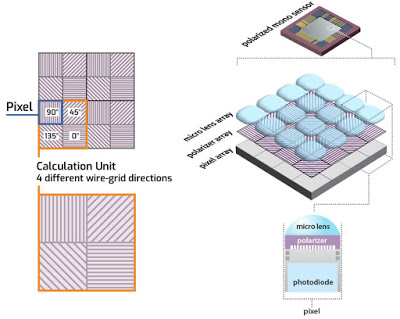 On-chip polarization is a revolutionary new way to polarize light in machine vision applications. Sony’s new IMX250MZR CMOS sensor, the first of its kind, uses a new architecture with polarizers on-chip as opposed to on-glass. This brings a number of benefits to machine vision applications that require polarization of light.
On-chip polarization is a revolutionary new way to polarize light in machine vision applications. Sony’s new IMX250MZR CMOS sensor, the first of its kind, uses a new architecture with polarizers on-chip as opposed to on-glass. This brings a number of benefits to machine vision applications that require polarization of light.
Whether you need to remove light reflecting off objects during inspection, or improve contrast for object recognition, on-chip polarizing sensors are a flexible, adaptive technology for higher quality machine vision.
The Benefits of On-Chip Polarization
On-chip polarization provides many productivity benefits over traditional methods of polarization. Typically, lens filters were required to polarize light, but this was an unproductive and inefficient method of polarization. Filters needed to be changed regularly to filter different angles of light, creating unnecessary downtime. Polarizing sensors can be quickly and easily adjusted as needed.
Further, polarizing sensors can filter multiple angles of light simultaneously, opening up the potential for entirely new applications that weren’t possible with polarizing filters. Fewer cameras are needed with polarizing sensors because of this, allowing for lower initial investments in machine vision.
 How Do Polarizing Sensors Work?
How Do Polarizing Sensors Work?
Polarizing sensors deploy a unique design to more efficiently filter out unwanted angles of light. The primary innovation in Sony’s IMX250MZR sensor is the use of a wire grid structure underneath the micro lens array. The wire grid structure is arranged in four different angles at 0, 45, 90, and 135 degrees covering four pixels.
Angles of light parallel to the wire grid structure are effectively filtered out. Users of Sony’s polarized sensor have control over the wire grid structure, with the ability to adjust which pixels are turned on and off, essentially allowing for complete control over which angles of light are filtered out.
Polarizing sensors are a revolutionary new machine vision technology with many advantages over traditional forms of polarization. Leveraging a wire-grid polarizing structure on-chip, among a number of other innovations, polarizing sensors allow for more productive machine vision applications.
To learn more on this topic, download our ebook on Sony’s IMX250MZR sensor, “On-Chip Polarization: A Better Way to Polarize Light in Machine Vision Applications.”
